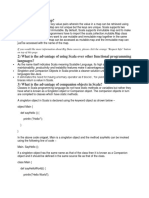File
File
Uploaded by
roopaudtCopyright:
Available Formats
File
File
Uploaded by
roopaudtOriginal Title
Copyright
Available Formats
Share this document
Did you find this document useful?
Is this content inappropriate?
Copyright:
Available Formats
File
File
Uploaded by
roopaudtCopyright:
Available Formats
Hive is a data warehousing tool that allows you to query and analyze data stored in
Hadoop Distributed File System (HDFS) using a SQL-like language called HiveQL.
Hive is typically used for batch processing and is optimized for complex queries
that involve large datasets.
Hive is used for batch processing and analytical queries OLAP (online analytical
processing) workloads,
In this scenario, you might use Hive to query and analyze the data, since Hive is
optimized for batch processing and analytical queries.
You can use HiveQL to write complex queries that aggregate and summarize the data,
nd Hive will translate these queries into MapReduce jobs that can be run on a
Hadoop cluster.
Hive will allow you to quickly process and analyze the large dataset to identify
trends and patterns in customer behavior.
HBase is a NoSQL database that is optimized for real-time read/write operations on
large datasets.
HBase stores data in a column-family format and provides random access to data
using row keys.
HBase is typically used for applications that require low-latency access to data,
such as online transaction processing (OLTP) and real-time analytics.
HBase is used for real-time read/write operations on large datasets. HBase is best
suited for OLTP (online transaction processing) and real-time analytics workloads.
HBase is optimized for real-time read/write operations on large datasets.
You can use HBase to store the transaction data in a column-family format and
access it using row keys.
This will allow you to quickly retrieve the transaction data for any given
transaction ID and process it in real-time
In HBase, row-level data deletion or modification is achieved through a mechanism
called "compaction". HBase stores data in "HFiles",
which are sorted and compressed files that contain multiple rows of data.
When a row of data is deleted or modified, HBase does not immediately remove the
data from the HFile.
Instead, it marks the data as "deleted" or "obsolete" and keeps it in the HFile.
To reclaim disk space and improve performance,
HBase periodically runs a compaction process that merges multiple HFiles together
and removes the obsolete data. During the compaction process,
HBase reads the data from the HFiles and writes the valid data to a new HFile. The
new HFile is then used to replace the old HFiles.
This process effectively removes the deleted or modified data from the HBase
cluster.
There are different types of compaction in HBase, including major compaction and
minor compaction.
Major compaction is a more resource-intensive process that merges all the HFiles in
a region into a single file and removes all obsolete data.
Minor compaction, on the other hand, merges a smaller number of HFiles and only
removes the obsolete data.
In summary, HBase allows row-level data deletion or modification through the use of
compaction,
which merges multiple HFiles together and removes obsolete data. This process helps
to reclaim disk space and improve performance in the HBase cluster.
Spark is preferred over Hive for high computations due to its in-memory processing,
powerful API, distributed computing capabilities, flexibility, and support for
real-time processing. These features allow Spark to process large datasets quickly
and efficiently,
making it a popular choice for big data processing and analytics.
Performance: Scala runs on the Java Virtual Machine (JVM). Since Spark is also
built on the JVM, JVM's performance optimizations.
Functional programming features: Spark heavily relies on functional programming
concepts,
such as immutability and higher-order functions, and Scala is a language that
natively supports these features.
Scala has a strong type system that helps catch errors at compile-time rather than
at runtime. This can help catch errors early in the development process, reducing
debugging time.
Compatibility with Java: Scala is fully interoperable with Java, which means that
Java libraries can be easily used in Scala code, and vice versa. T
his makes it easy to integrate Spark with other Java-based technologies.
Scala's performance, functional programming features, conciseness, strong type
system, and compatibility with Java make it a great choice for developing Spark
applications.
You might also like
- HbaseDocument13 pagesHbaseA2 MotivationNo ratings yet
- Unit VDocument6 pagesUnit VS.GOPINATH5035No ratings yet
- Big Data AnalyticsDocument13 pagesBig Data AnalyticsNeha KolteNo ratings yet
- Ibm HadoopDocument4 pagesIbm Hadoop4022 MALISHWARAN MNo ratings yet
- Unit 5 Big DataDocument34 pagesUnit 5 Big Data21csa30No ratings yet
- 6Document2 pages6Xenos Playground aka Boxman StudiosNo ratings yet
- Big Data Unit 5Document18 pagesBig Data Unit 5hemantsinghNo ratings yet
- Unit 5 BDADocument34 pagesUnit 5 BDAAmrithaNo ratings yet
- BDA1Document42 pagesBDA1abhics8050426993No ratings yet
- UNIT 5 NotesDocument47 pagesUNIT 5 NotesMarthala JagruthiNo ratings yet
- Hbase What Is Hbase?Document2 pagesHbase What Is Hbase?Muriel SozimNo ratings yet
- Apache HIVEDocument105 pagesApache HIVEhemanth kumar p100% (1)
- BD Unit 6Document6 pagesBD Unit 6Rucha GavasNo ratings yet
- HBaseDocument30 pagesHBasePapai RanaNo ratings yet
- HBaseDocument27 pagesHBasehemanthavanapu13No ratings yet
- HBASEDocument11 pagesHBASEshivangiyadav09022003No ratings yet
- Hadoop HBase Notes-Abhijit-NagargojeDocument24 pagesHadoop HBase Notes-Abhijit-NagargojeSanket PatilNo ratings yet
- 2 HadoopDocument20 pages2 HadoopYASH PRAJAPATINo ratings yet
- Hortonworks Data Platform (HDP)Document56 pagesHortonworks Data Platform (HDP)Harshit Bansal100% (1)
- HiveDocument2 pagesHivescribd.unguided000No ratings yet
- Hadoop Is A Framework That Is Widely Used For Storing and Managing Big DataDocument2 pagesHadoop Is A Framework That Is Widely Used For Storing and Managing Big DataSeid HussenNo ratings yet
- BDA Module 2-2023Document30 pagesBDA Module 2-2023recoverytherapy10No ratings yet
- Hadoop HBASEDocument71 pagesHadoop HBASEJhumri TalaiyaNo ratings yet
- Hadoop Ecosystem PDFDocument6 pagesHadoop Ecosystem PDFKittuNo ratings yet
- HBase - TutorialDocument14 pagesHBase - Tutorialucebittrichy2020No ratings yet
- Columnar DatabaseDocument18 pagesColumnar DatabaseXenos Playground aka Boxman StudiosNo ratings yet
- Hadoop EcosystemDocument21 pagesHadoop EcosystemSana KhanNo ratings yet
- Unit 3Document15 pagesUnit 3manasaNo ratings yet
- Unit 6Document26 pagesUnit 6gupta1803yashiNo ratings yet
- BigDataProcessingTools HaddopHDFSHiveSparkDocument2 pagesBigDataProcessingTools HaddopHDFSHiveSparkHenrique SantosNo ratings yet
- HbaseDocument6 pagesHbaseamitsachan47No ratings yet
- Apache HbaseDocument5 pagesApache HbaseiconocNo ratings yet
- Bigdata HadoopDocument4 pagesBigdata HadoopMutomba TichaonaNo ratings yet
- Big Data and Hadoop GuideDocument8 pagesBig Data and Hadoop GuideRoxana Godoy AstudilloNo ratings yet
- HbaseDocument3 pagesHbasescribd.unguided000No ratings yet
- Unit V-HiveDocument10 pagesUnit V-HiveSmitha RajeshNo ratings yet
- 13 LectureDocument23 pages13 Lecturezartasha574No ratings yet
- Apache HiveDocument3 pagesApache Hivekual21No ratings yet
- Cse 17CS82 M2 S4 PPTDocument19 pagesCse 17CS82 M2 S4 PPTVasanth KumarNo ratings yet
- BDA Unit 5 HIVE HBASEDocument33 pagesBDA Unit 5 HIVE HBASESREEKANTH ARKATNo ratings yet
- Ibiz HiveDocument27 pagesIbiz Hivesridr8No ratings yet
- Unit 5Document10 pagesUnit 5placementcell1234567890No ratings yet
- BigData Unit 2Document15 pagesBigData Unit 2Sreedhar ArikatlaNo ratings yet
- Unit V-HBaseDocument10 pagesUnit V-HBaseSmitha RajeshNo ratings yet
- Big Data and Hadoop OverviewDocument17 pagesBig Data and Hadoop OverviewShreekanth Vankamamidi, PMP100% (1)
- Big Data Introduction & EcosystemsDocument4 pagesBig Data Introduction & EcosystemsHarish ChNo ratings yet
- Hbase Understanding Mapreduce: Unit-2 P-2Document32 pagesHbase Understanding Mapreduce: Unit-2 P-2Domakonda NehaNo ratings yet
- BDA Unit-5Document26 pagesBDA Unit-5status wind skNo ratings yet
- Hana Selected Concepts For InterviewDocument29 pagesHana Selected Concepts For InterviewSatish KumarNo ratings yet
- HbaseDocument15 pagesHbasemadhuvanthi611No ratings yet
- Lesson1 Video1 TranscriptDocument2 pagesLesson1 Video1 Transcripth2a ChanduNo ratings yet
- HiveDocument12 pagesHiveshivangiyadav09022003No ratings yet
- BDT Unit 2 TextbookDocument20 pagesBDT Unit 2 TextbookN.C.YashaswiniNo ratings yet
- Assignment Group 3Document21 pagesAssignment Group 3Mutomba TichaonaNo ratings yet
- What Is The Hadoop Ecosystem?Document4 pagesWhat Is The Hadoop Ecosystem?Maanit SingalNo ratings yet
- Big Data Technology StackDocument12 pagesBig Data Technology StackKhalid Imran100% (1)
- Hbase Big Table: Oriented vs. Column-Oriented Data Stores. As Shown Below, in A RowDocument6 pagesHbase Big Table: Oriented vs. Column-Oriented Data Stores. As Shown Below, in A RowNaniSatishNo ratings yet
- Thejesh Venkata Arumalla: EducationDocument1 pageThejesh Venkata Arumalla: Educationubuntu100% (1)
- Getting Started With Python ProgrammingDocument1,484 pagesGetting Started With Python ProgrammingPoorna28100% (9)
- Chisel CheatsheetDocument2 pagesChisel Cheatsheet冠廷李No ratings yet
- Functional Programming in Java 8Document14 pagesFunctional Programming in Java 8Dagim Neway100% (1)
- Remaining Scala AssignmentsDocument16 pagesRemaining Scala Assignmentssayalibarhate2717No ratings yet
- Bjarnason TrampolinesDocument8 pagesBjarnason TrampolinesfaxecoNo ratings yet
- Final Unit 1Document35 pagesFinal Unit 1saranya.dNo ratings yet
- Scala Survey 2022 ResultsDocument41 pagesScala Survey 2022 ResultsfwwumffpmsunbgtsfeNo ratings yet
- Rohan Rajpal CV - March 2024Document2 pagesRohan Rajpal CV - March 2024rohanrajpal24No ratings yet
- Symbolic Script Programming For Java: June 2009Document17 pagesSymbolic Script Programming For Java: June 2009ryan aniceteNo ratings yet
- Donham 2018Document11 pagesDonham 2018zsoftNo ratings yet
- 70 8 (Prac)Document5 pages70 8 (Prac)BHARATH NAIDU KOMMINENINo ratings yet
- IT Salary Survey EU 2020Document54 pagesIT Salary Survey EU 2020Caio Castelan Basilio de AraujoNo ratings yet
- Python Data Science and Machine Learning Module - (DataScience-Bokeh) 18Document11 pagesPython Data Science and Machine Learning Module - (DataScience-Bokeh) 18Md Ohidur Rahman KhanNo ratings yet
- TheneophytesguidetoscalaDocument126 pagesTheneophytesguidetoscalahasumedicNo ratings yet
- Spark Syllabus 1Document3 pagesSpark Syllabus 1Prabhakar PrabhuNo ratings yet
- ScalaDocument15 pagesScalaSwaraj PatilNo ratings yet
- Scala Interview QuestionsDocument7 pagesScala Interview QuestionsNagendra VenkatNo ratings yet
- Module 4Document29 pagesModule 4hema22kNo ratings yet
- Introduction To CRISP DM Framework For Data Science and Machine LearningDocument7 pagesIntroduction To CRISP DM Framework For Data Science and Machine LearningrameshsripadaNo ratings yet
- Scala Data Analysis Cookbook - Sample ChapterDocument37 pagesScala Data Analysis Cookbook - Sample ChapterPackt Publishing100% (1)
- Big Data SMACK A Guide To Apache Spark, Mesos, Akka, Cassandra, and KafkaDocument277 pagesBig Data SMACK A Guide To Apache Spark, Mesos, Akka, Cassandra, and Kafkamannie100% (1)
- History of Programming Language: Ada Lovelace's Machine AlgorithmDocument5 pagesHistory of Programming Language: Ada Lovelace's Machine AlgorithmLaica Mea BelloNo ratings yet
- 8 XML ProcessingDocument2 pages8 XML Processingharshita singhNo ratings yet
- Java8 SlidesDocument104 pagesJava8 SlidesAnandNo ratings yet
- 5 Types of Programming Languages - CourseraDocument1 page5 Types of Programming Languages - Courseratoshiroelric07No ratings yet
- Functional Programming in SCALADocument2 pagesFunctional Programming in SCALADreamtech Press33% (3)
- Essential Slick 3 PDFDocument214 pagesEssential Slick 3 PDFLeonardo NascimentoNo ratings yet
- Akka Documentation: Release 1.1.2Document291 pagesAkka Documentation: Release 1.1.2quesoponNo ratings yet
- Introduction Data Science Programming Handout Set 1ADocument53 pagesIntroduction Data Science Programming Handout Set 1Adinoda6464No ratings yet

























































































